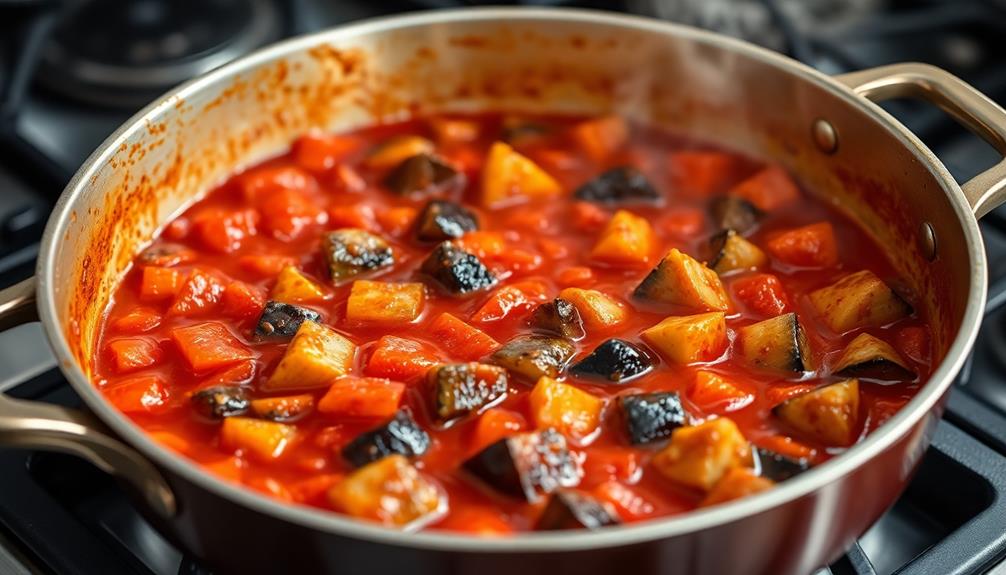Caponata is an amazing Sicilian dish that'll make your taste buds dance! It starts with tender eggplant and mixes in juicy tomatoes, briny olives, and zesty spices. The sweet-and-sour flavors create a party in your mouth. You can enjoy caponata as a side, topping, or even the main event. Just serve it with some crusty bread and let the magic happen. It's been a cherished part of Sicilian celebrations for centuries, and once you try it, you'll see why. So, if you're ready to explore the rich flavors of Sicily, dive into the world of caponata!
Key Takeaways
- Caponata is a classic Sicilian dish featuring a sweet-and-sour flavor profile, made with eggplant, tomatoes, olives, and a vinegar-based dressing.
- The dish originated from Arab culinary traditions in medieval Sicily, combining local vegetables with exotic spices, and has evolved over centuries.
- Caponata is versatile, serving as a side, topping, or main course, and is often part of traditional Sicilian antipasto or paired with grilled meats.
- The recipe typically includes ingredients like pine nuts or capers, with some variations being sweeter, and the dish is best served at room temperature or chilled.
- Caponata is a cherished dish in Sicilian celebrations and gatherings, and it can be prepared in advance, with the flavors improving after a day in the refrigerator.
History
Caponata, a beloved Sicilian dish, finds its origins in the Arab culinary traditions that heavily influenced the island's cuisine during the medieval period.
Back then, Sicilian chefs combined local vegetables like eggplant, celery, and tomatoes with exotic spices and herbs introduced by their Arab neighbors. The result was a vibrant, tangy, and savory dish that quickly became a beloved part of Sicilian culture.
Over the centuries, caponata has evolved, with every family and region developing their own unique twist. Some add pine nuts or olives, while others prefer a sweeter version with a touch of sugar.
Regardless of the recipe, caponata remains a cherished part of Sicilian celebrations and family gatherings, a delicious reminder of the island's rich cultural heritage.
Whether served as an appetizer, a side dish, or even a main course, caponata is a true taste of Sicily's vibrant and flavorful past.
Recipe
Caponata is a classic Sicilian dish that combines sweet and sour flavors. It's a versatile eggplant-based dish that can be served as a side, a topping, or even as a main course. The rich, complex flavors of caponata make it a true delight to prepare and enjoy.
Caponata is a dish that showcases the best of Sicilian cuisine. The combination of eggplant, tomatoes, olives, and a sweet-and-sour dressing creates a harmonious balance of textures and flavors. The dish is often served as part of a traditional Sicilian antipasto, but it also makes a wonderful accompaniment to grilled meats or fish. Additionally, caponata can be enjoyed as a standalone dish with crusty bread or as a topping for bruschetta. Its versatility and rich taste make it a beloved staple in Sicilian households and restaurants alike. For those looking to elevate the dish even further, consider adding a sprinkle of bottarga for an extra burst of flavor. For those unfamiliar with Sicilian cuisine, you may be wondering, what is bottarga? Bottarga is a delicacy made from cured fish roe, often used as a topping or seasoning in Italian and Mediterranean dishes.
Ingredients:
- 1 large eggplant, cut into 1-inch cubes
- 1/4 cup olive oil
- 1 onion, diced
- 3 celery stalks, diced
- 2 garlic cloves, minced
- 1 (14-ounce) can diced tomatoes
- 2 tablespoons red wine vinegar
- 2 tablespoons capers, rinsed and drained
- 1/4 cup pitted green olives, chopped
- 2 tablespoons sugar
- Salt and freshly ground black pepper to taste
- Fresh basil leaves for garnish (optional)
Instructions:
Sauté the eggplant in the olive oil in a large skillet over medium-high heat until golden brown, about 5-7 minutes. Remove the eggplant from the skillet and set aside.
In the same skillet, sauté the onion and celery until softened, about 5 minutes. Add the garlic and cook for an additional minute. Stir in the diced tomatoes, red wine vinegar, capers, olives, and sugar. Bring the mixture to a simmer and cook for 10-15 minutes, stirring occasionally, until the flavors have melded.
Return the eggplant to the skillet and cook for an additional 5 minutes. Season with salt and pepper to taste.
Caponata is best served at room temperature or chilled. It can be made a day in advance, which allows the flavors to fully develop. For a more robust flavor, consider adding a splash of red wine or balsamic vinegar to the dressing. Garnish with fresh basil leaves for a pop of color and freshness.
Cooking Steps
Chop the eggplant into 1-inch cubes, then sauté the onions and garlic until fragrant.
Next, add the tomatoes, capers, and olives, and let the mixture simmer until the eggplant is tender and the flavors meld together perfectly.
Step 1. Chop Eggplant Into 1-Inch Cubes

First, give the eggplant a good rinse under cool running water. This'll wash away any dirt or debris.
Now, grab a sharp knife and carefully slice the eggplant into 1-inch cubes. Don't worry if they're not perfect – they'll still taste delicious! Make sure to work slowly and keep those fingers tucked in to avoid any accidents.
Next, grab a sturdy cutting board and start chopping. Slice the eggplant lengthwise, then crosswise to get those perfect little cubes.
As you work, keep an eye out for any soft or discolored spots – you'll want to trim those off before adding the eggplant to your dish.
Once all the eggplant is cubed, give the pieces a gentle toss to make sure they're evenly sized. This will help them cook at the same rate.
Now you're ready to move on to the next step – sautéing the eggplant until it's golden brown and irresistibly tender. Get ready for some serious flavor!
Step 2. Saute Onions and Garlic

With the eggplant cubed and ready to go, it's time to turn your attention to the onions and garlic.
Grab a large skillet and heat it over medium heat. Once it's nice and warm, add a couple of tablespoons of olive oil.
Now, it's time to add the onions. Slice them up and toss them into the pan. Stir them around until they start to soften and turn golden brown, about 5 minutes.
Next, add the garlic. You'll want to mince or finely chop a few cloves. Toss them in the pan and give everything a good stir. The garlic will release its amazing aroma and start to sizzle.
Cook for another 2-3 minutes, being careful not to let the garlic burn. You want it to be fragrant and lightly browned.
Once the onions and garlic are perfectly sautéed, you're ready to move on to the next step in creating your delicious caponata!
Step 3. Add Tomatoes

Next, add the diced tomatoes to the pan with the sautéed onions and garlic. Watch as the vibrant red tomatoes come to life, sizzling and releasing their juicy flavors. Stir everything together, making sure the tomatoes are well-incorporated. The aroma of the garlic, onions, and tomatoes will start to fill the air, making your mouth water in anticipation.
Now, let the mixture simmer for a few minutes, allowing the tomatoes to break down and meld with the other ingredients. As the caponata begins to thicken, you'll see the flavors deepening and melding together.
Keep an eye on it, stirring occasionally, until the tomatoes have softened and the sauce has reached your desired consistency.
With the tomatoes added, you're one step closer to creating the perfect caponata. Get ready for the next step, where you'll add the remaining ingredients to bring this classic dish to life!
Step 4. Add Capers and Olives

After the tomatoes have had a chance to meld with the other ingredients, it's time to add the briny capers and olives. These flavorful additions will really make your caponata shine!
First, grab a handful of briny, salty capers and toss them into the pan. The capers will add a delightful burst of flavor, complementing the sweetness of the tomatoes and the richness of the eggplant.
Next, slice some juicy green or black olives and add them to the mix. The olives' salty, buttery taste will perfectly balance the other ingredients, creating a harmonious blend of flavors.
Gently stir everything together, making sure the capers and olives are evenly distributed throughout the caponata. The colors will really pop, with the deep purple eggplant, the bright red tomatoes, the green olives, and the little bursts of the caper flowers.
Now your caponata is well on its way to becoming a flavor-packed masterpiece!
Step 5. Simmer Until Eggplant Is Tender

Once the capers and olives have been incorporated, let the caponata simmer gently on the stovetop until the eggplant becomes meltingly tender. This could take about 20-25 minutes, so be patient and let the flavors meld together.
Stir the mixture every few minutes to ensure even cooking. You'll know the eggplant is done when it's so soft it practically falls apart with the gentle poke of a fork. The veggies should be tender but still hold their shape.
As the caponata simmers, your kitchen will fill with the tantalizing aroma of the sautéed vegetables, herbs, and vinegar. This is the magic moment when all the ingredients come together in perfect harmony.
Grab a spoon and take a taste – the balance of sweet, sour, and savory flavors will have you wanting to dive right in!
Final Thoughts
Caponata is a flavorful Sicilian eggplant dish that makes for a delightful appetizer or side.
Now that you've simmered the eggplant until it's tender, it's time to give this dish a final touch. The sweet-and-sour flavors of the caponata will have your taste buds dancing!
Serve it up with crusty bread or crackers, and you've got a tasty treat that's sure to impress.
Don't be afraid to get creative – you can add chopped nuts, fresh herbs, or a sprinkle of cheese to make it your own.
And don't forget, caponata is even better the next day, so feel free to make a big batch and enjoy it all week long.
Frequently Asked Questions
What Is the Origin of the Name "Caponata"?
You're wondering about the origin of the name "caponata," aren't you? Well, it's believed to come from the Sicilian word "cappuna," referring to a type of castrated rooster that was often used in the dish.
How Long Does Caponata Keep in the Refrigerator?
Caponata can keep in the refrigerator for up to a week when stored properly in an airtight container. The acidity and oil in the dish help preserve it, so you can enjoy its flavors for days.
Can Caponata Be Frozen for Later Use?
You can absolutely freeze caponata for later use. Simply allow it to cool completely, then transfer it to an airtight container or freezer bag. It'll keep in the freezer for up to 3 months, ready to enjoy whenever you need it.
Is Caponata Meant to Be Served Hot or Cold?
Caponata can be served either hot or cold, depending on your personal preference. It's a versatile dish that can be enjoyed warm or chilled, allowing you to tailor the serving temperature to your taste.
What Are Some Alternative Ingredients for Caponata?
Alternative ingredients for caponata can include zucchini, bell peppers, olives, pine nuts, raisins, or even anchovies. You can get creative and experiment with different vegetables, nuts, and flavors to personalize your caponata recipe.









